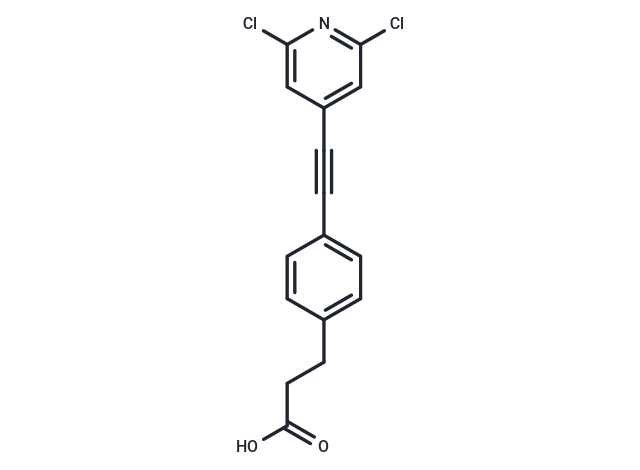Shopping Cart
Remove All Your shopping cart is currently empty
Your shopping cart is currently empty
TUG-499 is a selective free fatty acid receptor 1 (FFAR1 or GPR40) agonist (EC50: 7.39). It shows higher affinity for FFAR1 or GPR40 relative to related receptors FFA2, FFA3, and the nuclear receptor PPARγ, as well as various other receptors, ion channels, and transporter proteins. TUG-499 is useful for studying Type 2 diabetes.

| Pack Size | Price | USA Warehouse | Global Warehouse | Quantity |
|---|---|---|---|---|
| 2 mg | $30 | - | In Stock | |
| 5 mg | $48 | - | In Stock | |
| 10 mg | $68 | - | In Stock | |
| 25 mg | $117 | - | In Stock | |
| 50 mg | $156 | - | In Stock | |
| 100 mg | $205 | - | In Stock | |
| 1 mL x 10 mM (in DMSO) | $50 | - | In Stock |
| Description | TUG-499 is a selective free fatty acid receptor 1 (FFAR1 or GPR40) agonist (EC50: 7.39). It shows higher affinity for FFAR1 or GPR40 relative to related receptors FFA2, FFA3, and the nuclear receptor PPARγ, as well as various other receptors, ion channels, and transporter proteins. TUG-499 is useful for studying Type 2 diabetes. |
| Targets&IC50 | FFAR1/GPR40:7.39(pEC50) |
| In vitro | TUG-499 exhibits remarkable chemical stability, does not inhibit specific CYP enzymes or P-glycoprotein, and displays outstanding Caco-2 permeability. Its potent effects are observed on recombinant human FFA1 receptors as well as the INS-1E rat insulinoma cell line.[1] |
| Molecular Weight | 320.17 |
| Formula | C16H11Cl2NO2 |
| Cas No. | 1206629-08-4 |
| Smiles | C(#CC1=CC=C(CCC(O)=O)C=C1)C=2C=C(Cl)N=C(Cl)C2 |
| Relative Density. | 1.42 g/cm3 (Predicted) |
| Storage | Powder: -20°C for 3 years | In solvent: -80°C for 1 year | Shipping with blue ice/Shipping at ambient temperature. | ||||||||||||||||||||||||||||||
| Solubility Information | DMSO: 22.5 mg/mL (70.28 mM), Sonication is recommended. | ||||||||||||||||||||||||||||||
| In Vivo Formulation | 10% DMSO+90% Corn Oil: 2 mg/mL (6.25 mM), Sonication is recommeded. Please add the solvents sequentially, clarifying the solution as much as possible before adding the next one. Dissolve by heating and/or sonication if necessary. Working solution is recommended to be prepared and used immediately. The formulation provided above is for reference purposes only. In vivo formulations may vary and should be modified based on specific experimental conditions. | ||||||||||||||||||||||||||||||
Solution Preparation Table | |||||||||||||||||||||||||||||||
DMSO
| |||||||||||||||||||||||||||||||
| Size | Quantity | Unit Price | Amount | Operation |
|---|

Copyright © 2015-2026 TargetMol Chemicals Inc. All Rights Reserved.